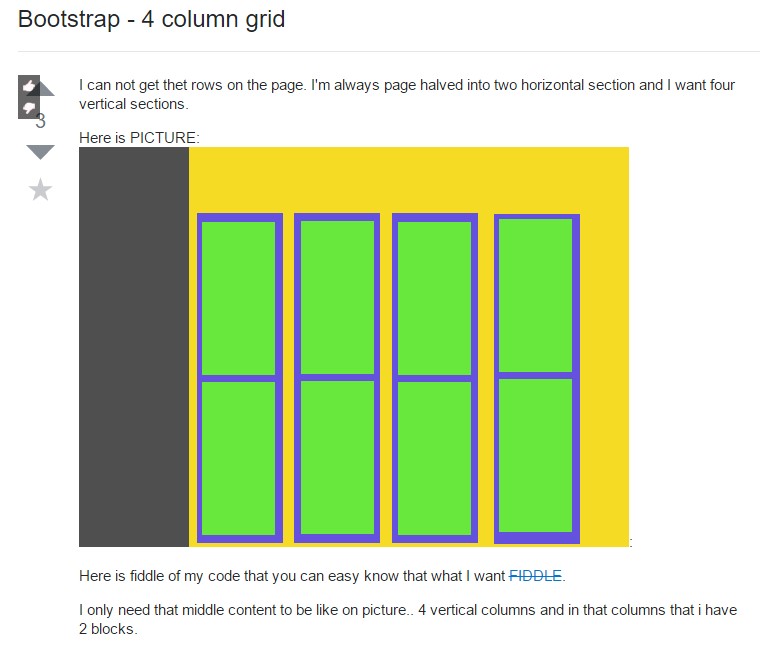Bootstrap Grid CSS
Overview
Bootstrap provides a helpful mobile-first flexbox grid solution for creating layouts of all shapes and sizes . It is simply founded on a 12 column style and features a number of tiers, one for each and every media query variety. You can surely apply it using Sass mixins or of the predefined classes.
The absolute most necessary part of the Bootstrap platform making it possible for us to create responsive web pages interactively changing in order to regularly suit the width of the screen they become displayed on continue to looking beautifully is the so called grid structure. What it basically does is delivering us the capability of designing complicated designs combining row and a special quantity of column elements kept within it. Visualize that the visible size of the display is separated in twelve equivalent elements vertically.
Efficient ways to employ the Bootstrap grid:
Bootstrap Grid Template uses a set of containers, rows, and columns to format as well as straighten web content. It's built by using flexbox and is totally responsive. Listed below is an example and an in-depth review ways in which the grid integrates.
The above situation builds three equal-width columns on little, normal, large size, and extra large gadgets using our predefined grid classes. All those columns are focused in the page with the parent
.containerHere is likely the ways it performs:
- Containers provide a methods to center your website's materials. Work with
.container.container-fluid- Rows are horizontal bunches of columns which make certain your columns are lined up appropriately. We utilize the negative margin method on
.row- Web content has to be put within columns, also only columns may be immediate children of rows.
- Thanks to flexbox, grid columns free from a established width is going to automatically design using same widths. As an example, four instances of
.col-sm- Column classes indicate the variety of columns you 'd like to utilize from the potential 12 per row. { Therefore, assuming that you need three equal-width columns, you can surely utilize
.col-sm-4- Column
widths- Columns possess horizontal
paddingmarginpadding.no-gutters.row- There are 5 grid tiers, one for each responsive breakpoint: all breakpoints (extra small-sized), small-sized, standard, large size, and extra large.
- Grid tiers are built on minimal widths, implying they put on that one tier and all those above it (e.g.,
.col-sm-4- You have the ability to employ predefined grid classes or else Sass mixins for more semantic markup.
Bear in mind the limits and also bugs about flexbox, like the lack of ability to employ a number of HTML features as flex containers.
Looks pretty good? Great, let us proceed to discovering everything with an example. ( more helpful hints)
Bootstrap Grid HTML solutions
Generally the column classes are something like that
.col- ~ grid size-- two letters ~ - ~ width of the element in columns-- number from 1 to 12 ~.col-The moment it approaches the Bootstrap Grid System scales-- all of the available sizes of the viewport (or the visual location on the display) have been actually separated to five varieties just as comes after:
Extra small-- sizes under 544px or 34em (which happens to be the default measuring system within Bootstrap 4
.col-xs-*Small – 544px (34em) and over until 768px( 48em )
.col-sm-*Medium – 768px (48em ) and over until 992px ( 62em )
.col-md-*Large – 992px ( 62em ) and over until 1200px ( 75em )
.col-lg-*Extra large-- 1200px (75em) and anything bigger than it
.col-xl-*While Bootstrap utilizes
emrempxDiscover the way in which parts of the Bootstrap grid system do a job around a number of tools having a useful table.
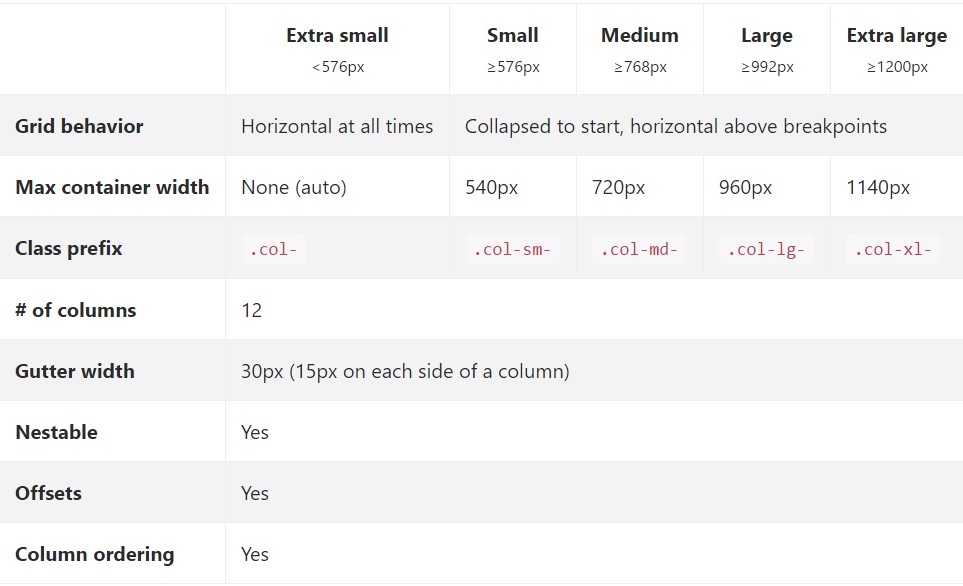
The brand new and several from Bootstrap 3 here is one special width range-- 34em-- 48em being assigned to the
xsAll the elements designated with a certain viewport width and columns manage its overall size in width when it comes to this viewport and all above it. The moment the width of the display screen gets below the determined viewport size the features stack over one another stuffing the entire width of the view .
You may also designate an offset to an element via a pointed out amount of columns in a specified display sizing and more than this is made out the classes
.offset- ~ size ~ - ~ columns ~.offset-lg-3.col- ~ size ~-offset- ~ columns ~A few things to consider anytime designing the markup-- the grids featuring rows and columns really should be inserted into a
.container.container.container-fluidPersonal descendants of the containers are the
.rowAuto style columns
Apply breakpoint-specific column classes for equal-width columns. Add in any variety of unit-less classes for each breakpoint you need and every column will be the exact same width.
Equal size
For example, here are two grid formats that used on every device and viewport, from
xs
<div class="container">
<div class="row">
<div class="col">
1 of 2
</div>
<div class="col">
1 of 2
</div>
</div>
<div class="row">
<div class="col">
1 of 3
</div>
<div class="col">
1 of 3
</div>
<div class="col">
1 of 3
</div>
</div>
</div>Placing one column size
Auto-layout for the flexbox grid columns as well shows you may set up the width of one column and the others are going to automatically resize all around it. You can use predefined grid classes ( just as shown here), grid mixins, or inline widths. Keep in mind that the different columns will resize no matter the width of the center column.

<div class="container">
<div class="row">
<div class="col">
1 of 3
</div>
<div class="col-6">
2 of 3 (wider)
</div>
<div class="col">
3 of 3
</div>
</div>
<div class="row">
<div class="col">
1 of 3
</div>
<div class="col-5">
2 of 3 (wider)
</div>
<div class="col">
3 of 3
</div>
</div>
</div>Variable size material
Applying the
col- breakpoint -auto
<div class="container">
<div class="row justify-content-md-center">
<div class="col col-lg-2">
1 of 3
</div>
<div class="col-12 col-md-auto">
Variable width content
</div>
<div class="col col-lg-2">
3 of 3
</div>
</div>
<div class="row">
<div class="col">
1 of 3
</div>
<div class="col-12 col-md-auto">
Variable width content
</div>
<div class="col col-lg-2">
3 of 3
</div>
</div>
</div>Identical width multi-row
Make equal-width columns that go across multiple rows by placing a
.w-100.w-100
<div class="row">
<div class="col">col</div>
<div class="col">col</div>
<div class="w-100"></div>
<div class="col">col</div>
<div class="col">col</div>
</div>Responsive classes
Bootstrap's grid provides five tiers of predefined classes to get building complex responsive styles. Customize the size of your columns upon extra small, small, medium, large, or possibly extra large devices however you see fit.
All breakpoints
To grids which are the exact same from the smallest of gadgets to the largest sized, employ the
.col.col-*.col
<div class="row">
<div class="col">col</div>
<div class="col">col</div>
<div class="col">col</div>
<div class="col">col</div>
</div>
<div class="row">
<div class="col-8">col-8</div>
<div class="col-4">col-4</div>
</div>Piled to horizontal
Making use of a single set of
.col-sm-*
<div class="row">
<div class="col-sm-8">col-sm-8</div>
<div class="col-sm-4">col-sm-4</div>
</div>
<div class="row">
<div class="col-sm">col-sm</div>
<div class="col-sm">col-sm</div>
<div class="col-sm">col-sm</div>
</div>Combine and match
Don't want your columns to just pile in a number of grid tiers? Work with a mixture of various classes for every tier as needed. Notice the example here for a best concept of ways in which all of it works.

<div class="row">
<div class="col col-md-8">.col .col-md-8</div>
<div class="col-6 col-md-4">.col-6 .col-md-4</div>
</div>
<!-- Columns start at 50% wide on mobile and bump up to 33.3% wide on desktop -->
<div class="row">
<div class="col-6 col-md-4">.col-6 .col-md-4</div>
<div class="col-6 col-md-4">.col-6 .col-md-4</div>
<div class="col-6 col-md-4">.col-6 .col-md-4</div>
</div>
<!-- Columns are always 50% wide, on mobile and desktop -->
<div class="row">
<div class="col-6">.col-6</div>
<div class="col-6">.col-6</div>
</div>Arrangement
Use flexbox positioning utilities to vertically and horizontally align columns. ( additional hints)
Vertical alignment
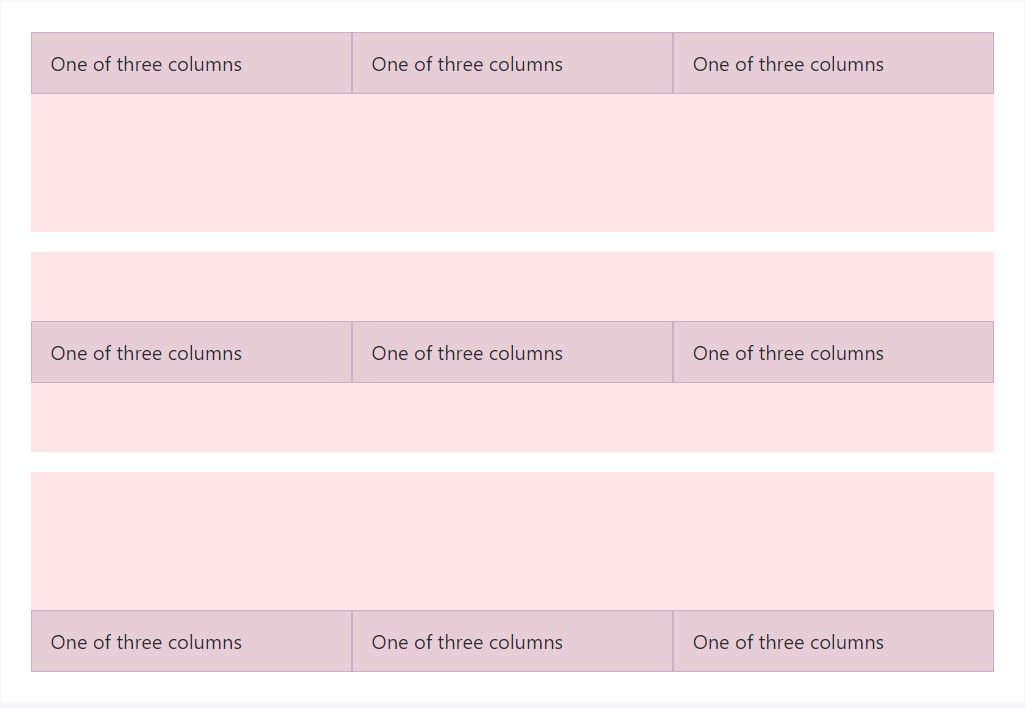
<div class="container">
<div class="row align-items-start">
<div class="col">
One of three columns
</div>
<div class="col">
One of three columns
</div>
<div class="col">
One of three columns
</div>
</div>
<div class="row align-items-center">
<div class="col">
One of three columns
</div>
<div class="col">
One of three columns
</div>
<div class="col">
One of three columns
</div>
</div>
<div class="row align-items-end">
<div class="col">
One of three columns
</div>
<div class="col">
One of three columns
</div>
<div class="col">
One of three columns
</div>
</div>
</div>
<div class="container">
<div class="row">
<div class="col align-self-start">
One of three columns
</div>
<div class="col align-self-center">
One of three columns
</div>
<div class="col align-self-end">
One of three columns
</div>
</div>
</div>Horizontal placement
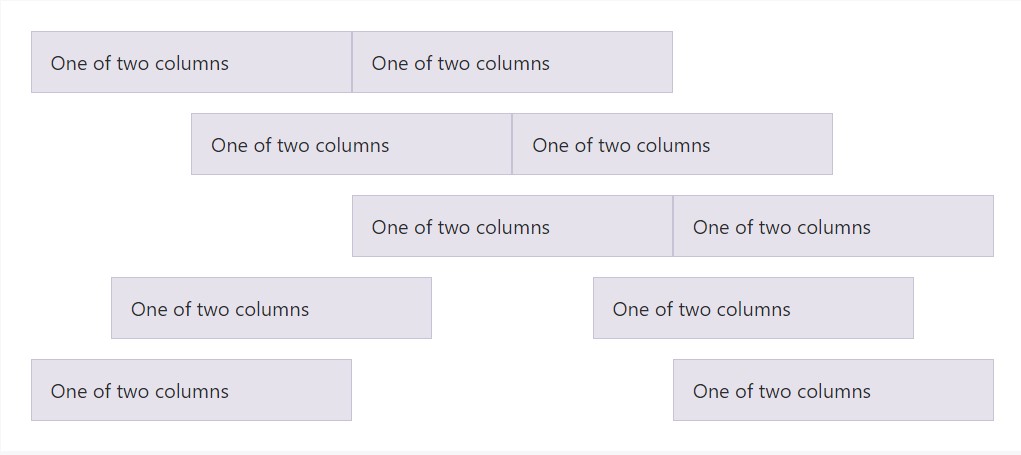
<div class="container">
<div class="row justify-content-start">
<div class="col-4">
One of two columns
</div>
<div class="col-4">
One of two columns
</div>
</div>
<div class="row justify-content-center">
<div class="col-4">
One of two columns
</div>
<div class="col-4">
One of two columns
</div>
</div>
<div class="row justify-content-end">
<div class="col-4">
One of two columns
</div>
<div class="col-4">
One of two columns
</div>
</div>
<div class="row justify-content-around">
<div class="col-4">
One of two columns
</div>
<div class="col-4">
One of two columns
</div>
</div>
<div class="row justify-content-between">
<div class="col-4">
One of two columns
</div>
<div class="col-4">
One of two columns
</div>
</div>
</div>No gutters
The gutters around columns within our predefined grid classes can be cleared away with
.no-guttersmargin.rowpaddingHere is actually the origin code for making these types of styles. Note that column overrides are scoped to only the first children columns and are intended via attribute selector. While this generates a more particular selector, column padding can easily still be additional modified together with space utilities.
.no-gutters
margin-right: 0;
margin-left: 0;
> .col,
> [class*="col-"]
padding-right: 0;
padding-left: 0;In practice, here's how it looks like. Take note you can continue to employ this together with all of the various other predefined grid classes ( providing column sizes, responsive tiers, reorders, and a lot more ).

<div class="row no-gutters">
<div class="col-12 col-sm-6 col-md-8">.col-12 .col-sm-6 .col-md-8</div>
<div class="col-6 col-md-4">.col-6 .col-md-4</div>
</div>Column wrap
In the case that over 12 columns are placed inside of a single row, each and every set of extra columns will, as one unit, wrap onto a new line.

<div class="row">
<div class="col-9">.col-9</div>
<div class="col-4">.col-4<br>Since 9 + 4 = 13 > 12, this 4-column-wide div gets wrapped onto a new line as one contiguous unit.</div>
<div class="col-6">.col-6<br>Subsequent columns continue along the new line.</div>
</div>Reseting of the columns
Along with the selection of grid tiers accessible, you are certainly bound to run into complications where, at particular breakpoints, your columns don't clear quite appropriate as one is taller compared to the another. To take care of that, make use of a combo of a
.clearfix
<div class="row">
<div class="col-6 col-sm-3">.col-6 .col-sm-3</div>
<div class="col-6 col-sm-3">.col-6 .col-sm-3</div>
<!-- Add the extra clearfix for only the required viewport -->
<div class="clearfix hidden-sm-up"></div>
<div class="col-6 col-sm-3">.col-6 .col-sm-3</div>
<div class="col-6 col-sm-3">.col-6 .col-sm-3</div>
</div>Along with column clearing up at responsive breakpoints, you may likely will need to reset offsets, pushes, or else pulls. Observe this in action in the grid scenario.

<div class="row">
<div class="col-sm-5 col-md-6">.col-sm-5 .col-md-6</div>
<div class="col-sm-5 offset-sm-2 col-md-6 offset-md-0">.col-sm-5 .offset-sm-2 .col-md-6 .offset-md-0</div>
</div>
<div class="row">
<div class="col-sm-6 col-md-5 col-lg-6">.col.col-sm-6.col-md-5.col-lg-6</div>
<div class="col-sm-6 col-md-5 offset-md-2 col-lg-6 offset-lg-0">.col-sm-6 .col-md-5 .offset-md-2 .col-lg-6 .offset-lg-0</div>
</div>Re-ordering
Flex order
Use flexbox utilities for dealing with the visual order of your content.

<div class="container">
<div class="row">
<div class="col flex-unordered">
First, but unordered
</div>
<div class="col flex-last">
Second, but last
</div>
<div class="col flex-first">
Third, but first
</div>
</div>
</div>Neutralizing columns
Shift columns to the right using
.offset-md-**.offset-md-4.col-md-4
<div class="row">
<div class="col-md-4">.col-md-4</div>
<div class="col-md-4 offset-md-4">.col-md-4 .offset-md-4</div>
</div>
<div class="row">
<div class="col-md-3 offset-md-3">.col-md-3 .offset-md-3</div>
<div class="col-md-3 offset-md-3">.col-md-3 .offset-md-3</div>
</div>
<div class="row">
<div class="col-md-6 offset-md-3">.col-md-6 .offset-md-3</div>
</div>Pushing and pulling
Effectively change the setup of our built-in grid columns along with
.push-md-*.pull-md-*
<div class="row">
<div class="col-md-9 push-md-3">.col-md-9 .push-md-3</div>
<div class="col-md-3 pull-md-9">.col-md-3 .pull-md-9</div>
</div>Material placing
To roost your web content together with the default grid, bring in a brand new
.row.col-sm-*.col-sm-*
<div class="row">
<div class="col-sm-9">
Level 1: .col-sm-9
<div class="row">
<div class="col-8 col-sm-6">
Level 2: .col-8 .col-sm-6
</div>
<div class="col-4 col-sm-6">
Level 2: .col-4 .col-sm-6
</div>
</div>
</div>
</div>Working with Bootstrap's origin Sass data
The moment using Bootstrap's source Sass data, you have the possibility of using Sass variables and mixins to generate custom, semantic, and responsive webpage styles. Our predefined grid classes use these exact same variables and mixins to supply a whole collection of ready-to-use classes for fast responsive arrangements .
Opportunities
Variables and maps identify the number of columns, the gutter width, and the media query aspect. We use these to generate the predefined grid classes detailed just above, and also for the custom made mixins listed below.
$grid-columns: 12;
$grid-gutter-width-base: 30px;
$grid-gutter-widths: (
xs: $grid-gutter-width-base, // 30px
sm: $grid-gutter-width-base, // 30px
md: $grid-gutter-width-base, // 30px
lg: $grid-gutter-width-base, // 30px
xl: $grid-gutter-width-base // 30px
)
$grid-breakpoints: (
// Extra small screen / phone
xs: 0,
// Small screen / phone
sm: 576px,
// Medium screen / tablet
md: 768px,
// Large screen / desktop
lg: 992px,
// Extra large screen / wide desktop
xl: 1200px
);
$container-max-widths: (
sm: 540px,
md: 720px,
lg: 960px,
xl: 1140px
);Mixins
Mixins are applied with the grid variables to create semantic CSS for individual grid columns.
@mixin make-row($gutters: $grid-gutter-widths)
display: flex;
flex-wrap: wrap;
@each $breakpoint in map-keys($gutters)
@include media-breakpoint-up($breakpoint)
$gutter: map-get($gutters, $breakpoint);
margin-right: ($gutter / -2);
margin-left: ($gutter / -2);
// Make the element grid-ready (applying everything but the width)
@mixin make-col-ready($gutters: $grid-gutter-widths)
position: relative;
// Prevent columns from becoming too narrow when at smaller grid tiers by
// always setting `width: 100%;`. This works because we use `flex` values
// later on to override this initial width.
width: 100%;
min-height: 1px; // Prevent collapsing
@each $breakpoint in map-keys($gutters)
@include media-breakpoint-up($breakpoint)
$gutter: map-get($gutters, $breakpoint);
padding-right: ($gutter / 2);
padding-left: ($gutter / 2);
@mixin make-col($size, $columns: $grid-columns)
flex: 0 0 percentage($size / $columns);
width: percentage($size / $columns);
// Add a `max-width` to ensure content within each column does not blow out
// the width of the column. Applies to IE10+ and Firefox. Chrome and Safari
// do not appear to require this.
max-width: percentage($size / $columns);
// Get fancy by offsetting, or changing the sort order
@mixin make-col-offset($size, $columns: $grid-columns)
margin-left: percentage($size / $columns);
@mixin make-col-push($size, $columns: $grid-columns)
left: if($size > 0, percentage($size / $columns), auto);
@mixin make-col-pull($size, $columns: $grid-columns)
right: if($size > 0, percentage($size / $columns), auto);An example operation
You can certainly modify the variables to your own custom made values, or else simply just use the mixins using their default values. Here is simply an example of employing the default configurations to develop a two-column format along with a gap in between.
View it at work in this provided case.
.container
max-width: 60em;
@include make-container();
.row
@include make-row();
.content-main
@include make-col-ready();
@media (max-width: 32em)
@include make-col(6);
@media (min-width: 32.1em)
@include make-col(8);
.content-secondary
@include make-col-ready();
@media (max-width: 32em)
@include make-col(6);
@media (min-width: 32.1em)
@include make-col(4);<div class="container">
<div class="row">
<div class="content-main">...</div>
<div class="content-secondary">...</div>
</div>
</div>Customizing the grid
Employing our integral grid Sass maps and variables , it is definitely possible to entirely modify the predefined grid classes. Alter the amount of tiers, the media query dimensions, and also the container sizes-- and then recompile.
Columns and gutters
The number of grid columns as well as their horizontal padding (aka, gutters) can be changed by means of Sass variables.
$grid-columns$grid-gutter-widthspadding-leftpadding-right$grid-columns: 12 !default;
$grid-gutter-width-base: 30px !default;
$grid-gutter-widths: (
xs: $grid-gutter-width-base,
sm: $grid-gutter-width-base,
md: $grid-gutter-width-base,
lg: $grid-gutter-width-base,
xl: $grid-gutter-width-base
) !default;Possibilities of grids
Going further than the columns themselves, you can likewise modify the quantity of grid tiers. Supposing that you preferred only three grid tiers, you 'd up-date the
$ grid-breakpoints$ container-max-widths$grid-breakpoints: (
sm: 480px,
md: 768px,
lg: 1024px
);
$container-max-widths: (
sm: 420px,
md: 720px,
lg: 960px
);If developing some changes to the Sass variables or maps , you'll require to save your adjustments and recompile. Doing so will out a new set of predefined grid classes for column widths, offsets, pushes, and pulls. Responsive visibility utilities definitely will also be upgraded to apply the custom breakpoints.
Final thoughts
These are practically the primitive column grids in the framework. Working with particular classes we can tell the individual elements to span a established variety of columns depending on the actual width in pixels of the exposed zone in which the web page becomes displayed. And given that there are certainly a a number of classes determining the column width of the items instead of reviewing everyone it is actually more useful to try to learn exactly how they certainly become created-- it is actually quite simple to remember featuring simply a couple of things in mind.
Examine a couple of video clip training relating to Bootstrap grid
Connected topics:
Bootstrap grid approved documentation
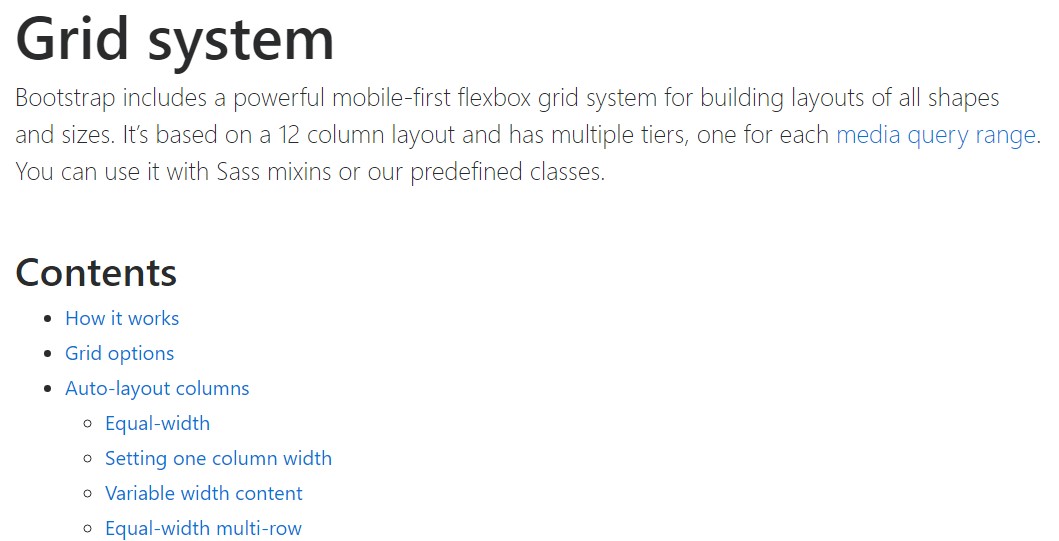
W3schools:Bootstrap grid information
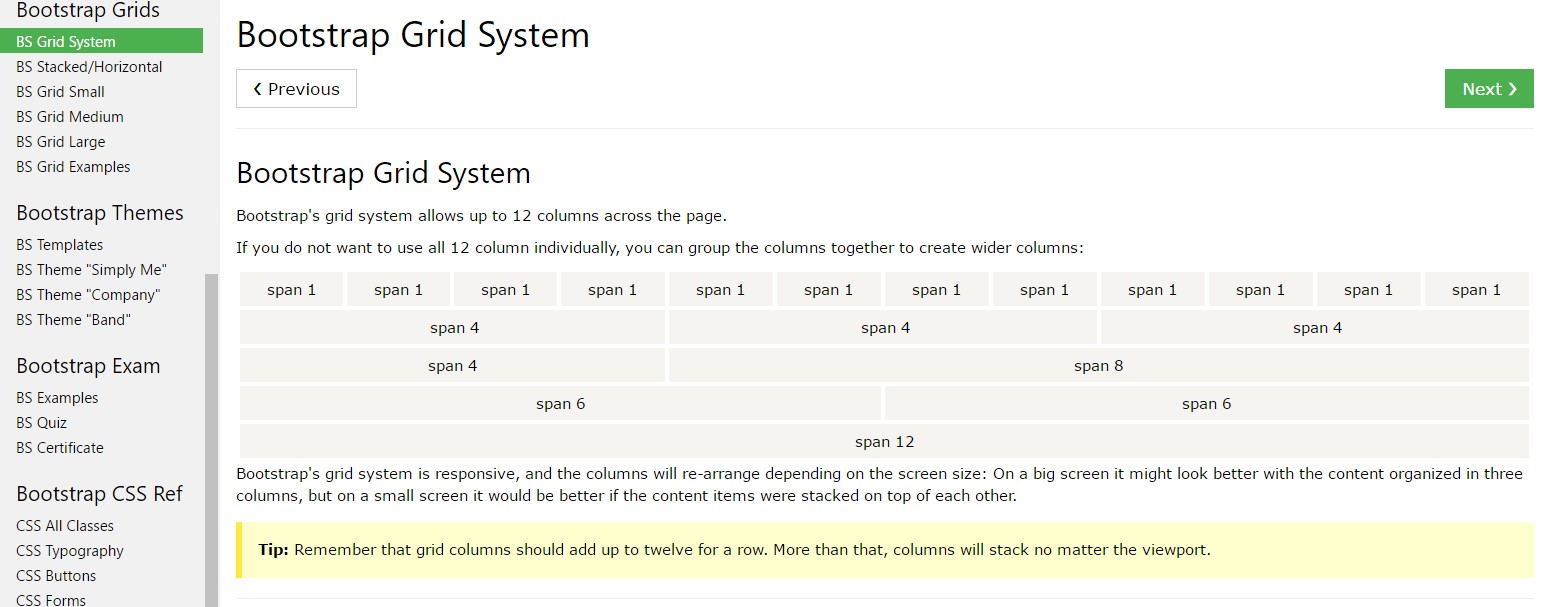
Bootstrap Grid column
